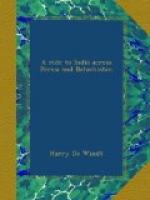As in most Eastern cities, each trade has its separate alley or thoroughfare in the Teheran bazaar. Thus of jewellers, silk mercers, tailors, gunsmiths, saddlers, coppersmiths, and the rest, each have their separate arcade. The shops or stalls are much alike in appearance, though they vary considerably in size. Behind a brick platform, about three feet wide and two feet in height, is the shop, a vaulted archway, in the middle of which, surrounded by his wares, kalyan [B] or cigarette in mouth, squats the shopkeeper. There are no windows. At night a few rough boards and a rough Russian padlock are the sole protection, saving a smaller apartment at the back of each stall, a kind of strong-room, guarded by massive iron-bound doors, in which the most valuable goods are kept. There is no attempt at decoration; a few only of the jewellers’ shops are whitewashed inside, the best being hung with the cheapest and gaudiest of French or German coloured prints. The stalls are usually opened about 6.30 a.m., and closed at sunset. An hour later the bazaar is untenanted, save for the watchmen and pariah dogs. The latter are seen throughout the day, sleeping in holes and corners, many of them almost torn to pieces from nightly encounters, and kicked about, even by children, with impunity. It is only at night that the brutes become really dangerous, and when, in packs of from twenty to thirty, they have been known to attack and kill men. Occasionally the dogs of one quarter of the bazaar attack those of another, and desperate fights ensue, the killed and wounded being afterwards eaten by the victors. It is, therefore, unsafe to venture out in the streets of Teheran after dark without a lantern and good stout cudgel.
From 11 to 12 a.m. is perhaps the busiest part of the day in the bazaar. Then is one most struck with the varied and picturesque types of Oriental humanity, the continuously changing kaleidoscope of native races from Archangel to the Persian Gulf, the Baltic Sea to Afghanistan.
Nor are contrasts wanting. Here is Ivanoff from Odessa or Tiflis, in the white peaked cap and high boots dear to every Russian, haggling over the price of a carpet with Ali Mahomet of Bokhara; there Chung-Yang, who has drifted here from Pekin through Siberia, with a cargo of worthless tea, vainly endeavouring to palm it off on that grave-looking Parsee, who, unfortunately for the Celestial, is not quite such a fool as he looks. Such a hubbub never was heard. Every one is talking or shouting at the top of their voices, women screaming, beggars whining, fruit and water sellers jingling their cymbals, while from the coppersmiths’ quarter hard by comes a deafening accompaniment in the shape of beaten metal. Occasionally a caravan of laden camels stalk gravely through the alleys, scattering the yelling crowd right and left, only to reassemble the moment it has passed, like water in the wake of a ship. Again it separates, and a sedan, preceded




